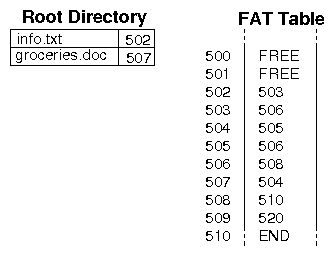- How big is the FAT table in bytes, and therefore, how many disk blocks will the FAT table occupy?
- Currently, there are only two files on the disk, and both are in the
root directory. The directory contents and the relevant portion of
the FAT table are shown below. All other FAT entries are marked `FREE'.

- The user creates a new file called index.htm which is 12,500 bytes long. Write out a suitable directory entry, and a list of disk blocks (separated by commas), that can be used to allocate space in the filesystem for this file.
- How much internal fragmentation occurs when index.htm is created? Explain your answer.
// Function to unlink the head node of a shared linked list
// and return a pointer to the node. If the list is empty,
// then a null pointer is returned.
Nodepointer getNode(Linkedlist L)
{
// Lock the list
acquire(L.semaphore);
// See if the list is empty and return if it is
if (L.headnode == null)
return(null);
// Find the first node from the list
Nodepointer n = L.headnode;
// Point the list's head at the node after n,
// and return the node n
L.headnode = n.next;
release(L.semaphore);
return(n);
}
- Why must the line release(L.semaphore); occur after the line L.headnode= n.next; What problems might occur if the lines were reversed?
- Given the function as it is written, how is it possible for the threads using this function to suffer starvation?
Explain the mechanism that is used to provide an abstract service to a process. What prevents the process from accessing the actual resources behind the abstract service?
- Disable all the interrupts
- Read the time-of-day clock
- Set the time-of-day clock
- Change the memory map
- First-come, first-served
- Shortest seek first
- SCAN
- C-SCAN